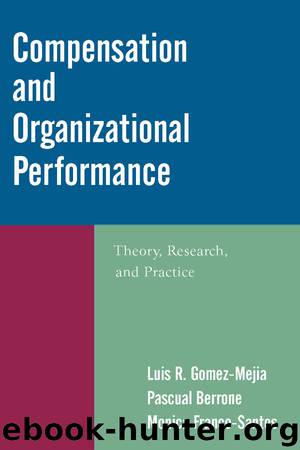Compensation and Organizational Performance: Theory, Research, and Practice by Luis R. Gomez-Mejia & Pascual Berrone & Monica Franco-Santos

Author:Luis R. Gomez-Mejia & Pascual Berrone & Monica Franco-Santos [Gomez-Mejia, Luis R.]
Language: eng
Format: azw3
ISBN: 9781317473954
Publisher: Taylor and Francis
Published: 2014-12-18T05:00:00+00:00
Source: Based on the research of Tosi and Gomez-Mejia (1989, 1992, 1994).
Figure 6.1
Influence Patterns in Management- and Owner-Controlled Firms
Source: Based on the research of Tosi and Gomez-Mejia (1989, 1992, 1994).
Figure 6.2
Characteristics of CEO Long-Term Income (LTI) and Bonus in Management-Controlled and Owner-Controlled Firms
A starting point for accomplishing this would be to remove management from the process of selecting board members. This could be achieved by the creation of independent offices, free from the hand of management, to manage the election of directors for publicly traded firms. They could make relevant performance information available to equity holders. They could facilitate coalitions of different stockholders and generally enhance owner involvement. Equity-holding managers would have rights similar to other stockholders for advocating candidates and positions.
This would require a federal law mandating that publicly traded firms use independent offices or agents to conduct director elections. These offices could be established outside the firm. They could be, for example, public accounting firms, law firms, or other organizations that may be created for that purpose. The board of directors for each firm could choose an outside agent, subject to the constraint that the agent does not have other business or professional relationships with the subject firm. The independent office would solicit slates for board election from stockholders. To minimize the number of slates but still provide opportunities for choice, the office could require that some minimum percentage of stock, say 1 percent, be held by individuals or coalitions who nominate candidates for the board.
To ensure that the competence and knowledge of the current management is represented in the election, the current board could nominate a single slate of candidates. The management of the firm would be permitted to nominate a slate to the extent that the candidates should meet the same holdings requirements as other equity holders. Information about proposals and programs of each nominated candidate or slate could be distributed in much the same fashion as is done under current practice, perhaps even in a simpler form. The equity holders could then select board members who hold positions similar to their own.
The independent office could also disseminate other information to equity holders through, for example, newsletters. These could contain proposals that might be useful to the larger population of stockholders. These could be a type of informal forum through which equity holders may communicate. There should also be provisions for arbitration or mediation processes when equity holders who do not control the legal minimum for slate nomination have grievances. This would limit the need for expensive legal action as equity holders seek to take advantage of ownership rights.
Tosi and Gomez-Mejia (1989) recognize that the proposal described here represents a departure from the current, general practice of board selection in the United States. Some of the issues that must be addressed in the development of legislation and its implementation include the following:
Download
This site does not store any files on its server. We only index and link to content provided by other sites. Please contact the content providers to delete copyright contents if any and email us, we'll remove relevant links or contents immediately.
Bad Blood by John Carreyrou(6275)
Rich Dad Poor Dad by Robert T. Kiyosaki(6175)
Principles: Life and Work by Ray Dalio(5961)
Playing to Win_ How Strategy Really Works by A.G. Lafley & Roger L. Martin(5500)
Management Strategies for the Cloud Revolution: How Cloud Computing Is Transforming Business and Why You Can't Afford to Be Left Behind by Charles Babcock(4438)
The Confidence Code by Katty Kay(4038)
Thinking in Bets by Annie Duke(3996)
American Kingpin by Nick Bilton(3508)
Delivering Happiness by Tony Hsieh(3283)
Project Animal Farm: An Accidental Journey into the Secret World of Farming and the Truth About Our Food by Sonia Faruqi(3018)
The Power of Habit by Charles Duhigg(2966)
Brotopia by Emily Chang(2897)
Mastering Bitcoin: Programming the Open Blockchain by Andreas M. Antonopoulos(2891)
The Tyranny of Metrics by Jerry Z. Muller(2846)
I Live in the Future & Here's How It Works by Nick Bilton(2844)
The Marketing Plan Handbook: Develop Big-Picture Marketing Plans for Pennies on the Dollar by Robert W. Bly(2793)
The Content Trap by Bharat Anand(2778)
Building a StoryBrand by Donald Miller(2754)
Applied Empathy by Michael Ventura(2752)
